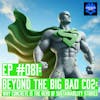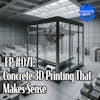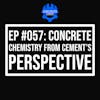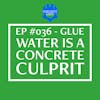EP #081: Beyond the Big Bad CO2: Why Concrete is the Hero of Sustainability Stories
In this Concrete Logic Podcast episode, Aaron Fisher discusses the importance of engaging with sustainability in the concrete industry. He highlights the need for concrete professionals to be part of the conversation and influence the rules and regulations being developed.
Aaron explains how the focus on CO2 emissions has led to an oversimplification of sustainability and the need to consider other factors such as water usage, fire resistance, and durability. He emphasizes the importance of presenting a comprehensive case for concrete's sustainability and resilience, and the need to push back against misleading messaging and lobbying efforts.
Takeaways
• Concrete professionals need to engage with the sustainability conversation and influence the rules and regulations being developed.
• The focus on CO2 emissions has led to an oversimplification of sustainability, and other factors such as water usage, fire resistance, and durability should be considered.
• Concrete has many advantages in terms of sustainability and resilience, including its long lifespan, fire resistance, and energy efficiency.
• A comprehensive case for concrete's sustainability and resilience needs to be presented, highlighting its benefits in comparison to other building materials.
• Concrete professionals should not shy away from the sustainability conversation and should actively promote the value of concrete in creating a more sustainable and resilient built environment.
Chapters
00:00 Introduction and Background
02:58 Engaging with Sustainability
10:07 Focus on Embodied Carbon
30:05 The Role of Lobbying and Messaging
40:13 Building a Stronger Case for Concrete
42:53 Conclusion and Call to Action
***
Did you learn something from this episode? If so, please consider donating to the show to help us continue to provide high-quality content for the concrete industry.
Donate here: https://www.concretelogicpodcast.com/support/
***
Episode References
Guest: Dr. Aaron Fisher | Ernest Maier| afisher@emcoblock.com
Guest Website: https://www.ernestmaier.com
Producers: Jodi Tandett
Donate & Become a Producer: https://www.concretelogicpodcast.com/support/
Music: Mike Dunton | https://www.mikeduntonmusic.com | mikeduntonmusic@gmail.com | Instagram @Mike_Dunton
Host: Seth Tandett, seth@concretelogicpodcast.com
Host LinkedIn: https://www.linkedin.com/in/seth-tandett/
Website: https://www.concretelogicpodcast.com/
LinkedIn: https://www.linkedin.com/company/concrete-logic-podcast
[00:00:00] Seth: Welcome to another episode of the Concrete Logic Podcast. And today I have Aaron Fisher back on the show with me. He was on episode 76. Aaron has a, I would say a pretty diverse background for being in the concrete business. We talked about fiberglass rebar on episode 76 with Aaron. But Aaron's got a chemical background.
And chemistry background and I've got the other what's the other degree you got in? Chemical engineering. All right. So Aaron today's joining us. He has several subjects that he wanted to talk to me about, but we try to only do 1, 1 topic and episode. But 1 of the things that Aaron is passionate about is sustainability.
And so we're going to talk a little bit about that today, and maybe how we could change our messaging to the folks that are also passionate about sustainability. But before we get started the same message, I send to you all every episode is this is a value for value podcast, which means.
I do my best to provide a value for you all through this podcast, and what I ask you to do is if you get some kind of value out of this, that you can do one of three things or all three things. I had someone do all three things, which I'm going to share that with you guys too. But anyway, so the first thing you can do is if you enjoy this podcast and you learn something out of it, share it with a colleague or coworker.
The second thing is if you go to ConcreteLogicPodcast.com, you can click on the contact button. There's a contact button and there's also a mic, a little microphone. You click on that, you can leave me a voicemail. And what I'm looking for there is just a guest or topic suggestions. So if you've got a, if you've.
Feel like I'm overlooking a topic or you got a really good guest. You want to bring up you want me to bring on the show. That's where you can do that. And then the third is you can click on the donate button that's on the homepage on concrete logic podcast. com and you can give any amount because.
You want to help with the cost of the podcast isn't free it's got software that we use it that we're using right now There's hardware these Microphones headphones all that stuff cost money. I'm not sponsored by anybody. I don't take money for anyone and the reason I do that is so we can do this podcast without those annoying advertisements.
I don't know if you guys listened to Joe Rogan at all, but man, that drives me nuts. Every time he's got somebody good on there. And then it seems every 15 minutes, you got some, he's talking about something that he uses. I really don't want to hear that. So anyways that is how this podcast is built.
So I appreciate you guys to support. All right, Aaron, I'm done with my part. Let's talk about sustainability. I think you got a good angle here that you're talking to. There might be maybe a blind spot that we have as a concrete industry. Maybe we are reluctant to talk to some folks about concrete because we don't think they're interested in what we're selling.
It's is this a good spot to start us off? Yeah.
[00:03:14] Aaron Fisher: Thanks, Seth. Thank you for having me back. Certainly know I can talk about a lot of different things. And but in talking sustainability, I think the biggest thing message I've had to my local region has been, if we don't engage on the topic sustainability, and we've all kind of heard about it, but if we don't engage with the topic and the folks who are making the rules, they are not going to do us any favors if we're not in the room.
And certainly there are certain, building materials that have pointed the attention at concrete and cement as being a very material that gives off a lot of CO2 globally. And they focus the sustainability message on that. They focus the regulators on that. And if we don't engage, what we end up with is rules.
At a playing field that really isn't level, it isn't fair to how good of a material concrete really is. And coming on this podcast, I reached back out to Seth and said, hey, I really want to talk sustainability because the audience here, for everybody who's listening it's a lot of people convinced the greatness of concrete, but you got to go spread the gospel.
And then certainly giving you guys some of the language and the framing to talk to the sustainability people so that. They understand the concrete truly is both a sustainable and a resilient material.
[00:04:26] Seth: I think what you're, you mentioned, though is I think we have folks that are out there that are I would say representing us as a, as an industry speak for to folks about sustainability. we've talked about this on the podcast before. My personal opinion on why we struggle with convincing folks that concrete is sustainable is not just.
I know everyone's hooked on the CO2 thing, which drives me nuts, but that's a whole other topic. But I think we have as a society, as humans, we have a very short. Attention span, we cannot think beyond what we're doing in the next. A couple of weeks mine, something that's going to last us 50 years.
No one I guess thinks in decades, but most folks don't think in decades. So when you tell them, hey, I'm going to build something out of concrete, that's going to last generations. I don't think that really resonates with people. So knowing that I don't know if that's the right angle to take, but yeah.
Aaron, and you probably have more conversations with these folks that you're referring to this sustainable group. And when I think of sustainable group, I think green building council. I think of urban land Institute. I think of architects in general, but the. You probably again, you probably had more conversations and I have with that group.
I'm I participate in some of those groups. And honestly, I guess sustainability topic doesn't really come up. They just, they, something is concrete and I'm standing around. They asked me about concrete. That's about it.
[00:06:18] Aaron Fisher: Yeah. And what we're seeing is it's moving in fits and starts.
So the sustainability community, the way I like to frame it is, most people, if you say someone's a green person or you can picture someone driving a Prius, eating granola, living on a commune and certainly, That kind of person, just that imagery just makes the person seem a little kooky, a little crazy that the guy, the person who walks into the town hall meeting and gets to put in their five minutes and you could see the town rep ignoring them.
And that has really changed in the last 30 years where Those folks, they under the sustainability community has polished at this point, they understand how to move the needle, how to win a public relations battle. And I'll call it, I'll call it tasks like the 1st place that allows sustainability focus people focused on was the power grid and.
You see how much wind and solar have come in and how much renewable portfolio standards and things like that. They've taken down very big bureaucracies that haven't trenched interest in using coal. They haven't transitioned using oil, like the TVA or the Bonneville power administration, like these are big government agencies and they've been able to move them from their thinking in the fifties to where they are today.
That every, basically every new megawatt of power they put on is. Is clean is green. And so that, that message shifted, probably the success shifted the 80s, 90s, 2000s, and then they started working on the transportation sector. And you can look at the ads that you saw in the Super Bowl.
A good chunk of them are for electric cars. They're electric pickup trucks. They know who they're advertising to is that they can, and the importance of, yeah. Reigning in emissions from vehicles is really important in terms of addressing if CO2 is what you're trying to do. Vehicles account for a lot of those emissions.
So they've worked on that sector, that industry and have moved that industry, the big three, the international players, they all have electric cars. Now, whether or not that ultimately becomes an all-electric fleet, that's not the argument here, but they are now offering those cars where five years ago, those cars were not on the market.
Like it was like a niche product. Toyota was offering or Nissan had one vehicle to now they are pretty every major manufacturer has not just 1, but several options. And so the next area, they focused on was the construction industry. We do account for a lot of emissions. There's obviously stormwater, all those kind of issues that you run into on a building site.
If you're going to tackle sustainability, there is a lot. To go after in the built environment. And these, as they moved over to the built environment, they were like, what can we tackle? What can, what issues can we address? And obviously one of the first things they went after is energy efficiency.
If you turn your lights off, if you get your HVAC down, if you build a more efficient system, they have been working on those issues. And certainly there's a lot of ASHRAE standards and code standards on that address energy efficiency. It's why. If you look at building a house now, the amount of insult, like the minimum price for a house is higher than it was because.
Code has made the building better because the code is requiring more energy efficiency out of the building passively. So you basically, what that means is if you need insulation in a wall, the insulation is directly related to how thick the wall is. A lot of contractors, depending on the building code, they can't build a two by fours anymore.
They got to use two by sixes to get the right amount of insulation in those walls. And certainly a lot of building jurisdictions have looked at green building codes and cranking on that further, and that would, they'd have to go to two by eights to get more insulation in the wall. So you're seeing things like that.
And so what, and I'll point specifically to the lumber industry really here has done is they've said, all right, if we're going to focus on where else do we get carbon in that value chain of building a property? It's not just in, carbon is not just emitted when you operate the building. It's when you first build it.
It takes energy to create the materials and then move them to the site and then assemble them into that building and that structure itself. So what the. What the lumber industry has done is they've, they have a product they want to sell. They want to sell more trees as lumber. And so what they've done is they've focused the sustainability community on a concept called embodied carbon.
So this is the amount of carbon that goes into the building, but they've specifically only focused on, in the life cycle world, what's called from cradle to gate. So that's from. The point that the tree is the materials extracted from the earth of the tree is cut to the point that it leaves the plant and a ship to the job site or ship to the distributor.
And that is what they've done because if you're comparing lumber and concrete, lumber is the best at the, at that point. And we are at our low point because when we produce. Cement from clinker. We have to drive off co2. That is just the chemical equation that goes that makes Portland cement from limestone.
It's ca co3 clinker, Cao, that missing thing is co2. That's what we admit to the environment. And so certainly we give that off. But as con as when you mix your concrete, you miss your cement back into your concrete and it cures. Some of that clinker recarbonates so some of that co2 comes back, but if we only look at the point that it leaves our plant gate, we don't get credit for that.
And it also doesn't account for over the life cycle. What happens at the end of it? So it's not just cradle to gate. It should be cradle to grave or even cradle to cradle. And again, talking to this audience here, we know that we can take a concrete building. It's going to stand forever until we decide we want to do something differently.
And then what we do is we crush that, and we reuse that that concrete as aggregate. But you think about a wood building. What do we do with that lumber? Once we take down the building, if you go through demolition on a building, you just drive it out of the dump. And what happens to it, it CO2. So while their product.
The tree eats CO2, ultimately, it only is temporarily storing it versus concrete, which is sequestering it. And so, a lot of the ideas that we've talked about with carbon capture and sequestration, so taking CO2 and just pulling it randomly out of the environment and then taking it out of the atmosphere, all those ideas have basically made concrete.
They've taken calcium oxide and sequestered in a geological formation of carbonate. They're basically remaking concrete. In seeing something like that, I'm trying to present an information so that when folks see all these rules that are coming down, they understand where they're coming from. And how detrimental they can be, because they're taking us at our worst because they're writing the rules.
So they look the best as the lumber industry, which is unfortunate. But if we don't engage and we don't point out this kind of nuance, we're going to lose that conversation. And we're going to be, we're going to be behind the eight ball trying to play catch up on
[00:13:16] Seth: that. Yeah uh,
the folks that you're talking, you're having these conversations with about sustainability, so concrete versus what we'll just say lumber or wood or whatever, can you talk specifically about why they there's some kind of pushback or whatever? I'm on there on just for fun. I went to the Nash. What the heck is this? 1 of the associations. I went to their website. Softwood lumber boards. I forgot this was what's an H L a national anyways.
They have a little image here from Dovetail Partners Incorporated, which I don't know who they are, but essentially, they're comparing lumber versus most of other building materials that you would see. In a construction project it's got lumber, concrete, brick, glass, recycled steel, cement, recycled aluminum, steel, plastic, and just regular aluminum.
And then it's comparing what's funny is they got a, misspelling on this thing, it's supposed to say carbon storage, but they misspelled storage anyways. So a lumber obviously is at the bottom of the list as far as process emissions and like emissions plus carbon storage. So what they're saying is lumber is basically carbon negative.
And then next in line is concrete. Which they're saying is times worse than lumber, if you're looking, if you were looking at this compared to lumber. So I was also thinking why you were, you're explaining the way we should message was this messaging. I really think is not necessarily needs to be say to the sustainability groups.
I just paying attention to what's going on. It seems the lobbyists in DC have more control on what comes through and this that is what?
What people are following is basically the money where the money's funneling So the government comes up with these programs and says hey if you're you know co2 negative or whatever you get this money and these grants or these funds or whatever. And that's what's driving all of this.
So to me where I feel like the concrete and cement industry fall short is the lobbying, which isn't. I wish they'd just get rid of lobbying. But I think it's all terrible. Lobbying is bad all together. But I think that's what, when I dug into this before Aaron was, I was like these other building material groups, especially wood They're really good at lobbying.
They get upstream of this stuff, and they control what the, the way these incentives are built. They're and when the, these incentives are built and I'm blanking out on an example, but Inflation, Inflation Reduction Act is one when those bills are made, they have language in there that incentivizes people to build in a certain way, right?
And create technologies and designs and things that are maybe not concrete friendly.
[00:16:46] Aaron Fisher: I think there's the disconnect between what. The sustainability community is trying to do and then how rules actually make things sustainable because the, what I call it is I talk about the UN definition of sustainability.
It says meeting the needs of the present without compromising the ability of future generations to meet their own needs. It doesn't talk about CO2. It doesn't talk about water. It doesn't talk about pollution. It just says we need to do things today without compromising things. That our kids do, and that doesn't say anything about CO2, and so what ends up happening is that somebody then goes what that means, and someone tries to play interpreter and then interprets that.
Goal into rules and then what they've done is they've focused on CO2 for better or worse, we're not going to be able to put that cap back in the bag. I think really sustainability is about all these different things. So I usually give this example that I said, if I had a material that it was low cost.
It worked well with everything else and was readily available. And when you put it in material, it made it fire resistant. You're like, that sounds great. Let's put that in everything. We did do that. That's asbestos. And we realized when we did that, we gave everyone mesothelioma. We gave a lot of late night commercials.
We gave a lot of people cancers because we didn't value. Everything and we couldn't wait everything and that's what we're seeing with co2 is this narrow laser like focus on co2. Seth, what you saw with that, the data is pretty accurate. Usually what I see is when the wood guys take all the numbers, they get to do everything they want.
They say they're about 10 percent better on a structure than concrete. I'm sure they're not doing much as much favors in terms of what they're looking at in terms of material selection and things like that. But What we can do is there's a lot of stuff we can do on in concrete to get 10 percent better.
I was on talking about fiberglass rebar, but PLCs SCMs, all of those things can take that number the concrete number and make that much better in a building, first of all. And then second of all, it's not just CO2. There's things like water biodiversity. If you have a forest growing and then you cut it down, the animals have no place to live.
We have quarries and they've been quarries and they stay quarries like there were, we're very dense in our operations. We don't clear cut acres and acres of land. We have our quarry and that's where we, that's our operations. That's where we go. Conversely, you look at, I talked about water a little bit, but I can also talk about when you get into a structure, concrete has other benefits.
When you build with a wood structure, wood is flammable or combustible. And so how do they get wood to meet fire code? They use gypsum. They use drywall to impart some fire protection to the wall. And so when you do things like that technically, yes, the lumber is the structural material and the drywall and the gypsum is not structural, but if you use that's the whole wall system, but the way they present numbers is they often.
Don't show that they require you to use gypsum. They don't show that there's other materials that are required. You look at an HVAC system, simply put, when you build out of concrete, you're building envelope is much more secure. The air that's in there stays in there and the air that's outside stays out there, which is great.
If you're trying to cool the air inside or heat the air inside so that you're comfortable, While the outside just stays natural, but if you have very leaky buildings, because you try to plywood together and the air just runs out through those seams, that's a problem. And but how does that account for it is and your MEPs, they can downsize their HVAC because if you're not.
If you're only, if you're not having to exchange air and heat up air from the outside to heat the interior, you can have a smaller HVAC unit. If you have a smaller HVAC unit, we all understand that A, that costs less, but B, that uses less energy and ultimately less CO2. But, a lot of times, they don't fully, value all of these other benefits that material like concrete brings to the table around fire protection, around HVAC and energy efficiency.
But there are industries that do value this. The insurance industry looks exactly at these things. They understand the value of a resilient structure, the value of a structure that if there was a fire doesn't burn to the ground, it's not a total loss. So the insurance industries value these things.
However, when we present our argument about what concrete is and what it does, we're talking about what the concrete costs, but the owner isn't thinking about what the concrete costs. They're thinking about how much money has to leave their pocket. So if it's going over to the insurance company, they don't like it.
As long as it's less than money, they don't care where that goes to the insurance company or to the building materials or the contractor. We got to start presenting that. And a lot of folks have done that. Hey, they've pulled together studies looking at building costs. over the life cycle. So it's not just what it costs to build it.
They've looked at the insurance, the builder's risk, because one of the last things a building gets that gets turned on is your fire suppression system. So we've all been on a job site. We've all seen the pictures that we were talking about. There's a few apartment buildings or multifamilies that burn to the ground because there was a spark on a job site and you have a bunch of kindling and you're structural if you use lumber and the structure usually more often than not is a loss because they can't figure out where the what is good and what is not good.
And but the insurance industry has already value that. All right, that's a total loss. We will factor that in based upon your premium. That's what it costs. And when you start factoring those in right from the get-go, you can start making a really strong case, not just over the life cycle, but even on initial costs on what it takes to get from a site.
To a building certainly, as we look over the lifetime, you mentioned the other thing you mentioned, Seth earlier, you talked about how long does a building go? That's really important. When you talk about embodied carbon, it doesn't make an accounting for how long that's how well that how functional that structure is, how long functionally it will stand.
There's a big difference. If you build a building for 20 years and then tear it down and rebuild it versus building a structure for 40 years, right from the get go, or 100 years, if you do that, the embodied carbon to tear down a building and rebuild it there, it just blows any kind of carbon budget you're trying to set.
And certainly understanding that rehab is much more efficient than new build in terms of carbon efficiency. But. Now you have to do more work, you have to spend more time understanding, are those beams in the column still in good shape? Can I use them? What can I add on to? What can I not? It does require a little bit more effort, and if I'm an engineer, my job, I usually call a lot of engineers to task, is their job really isn't to do, technically it's to do structural design nominally, their job is to get and hold permits.
And if you think about it that way, the easiest way to be certain that your building is going to stand is just to start over. And so that makes it very easy for the engineers to make that case. But then they come into the lemon Don and they go, hey, I need my concrete to be 5 percent better. You tore down a structure.
If this is where we want it to go, that probably is where you should have stayed is with that existing structure and added onto it, or looked at adding to it. That's not how it's sustainability is just this keyword. They throw in it's like salt. They just sprinkle in randomly and you go, if you're really going to have this sustainability discussion, you got to have it at all points of the building design and construction process is that is something like this necessary?
Because if you don't have to do anything, there's no CO2 embodied in doing nothing. The thing is spent that way. If you can retrofit or use existing, or if you look at it as you look at mix design, if I don't need my mixes to be high early strength. I can get a lot of carbon savings by not having them be high early strength.
We often, and so things like this come in, but oftentimes what we hear is they get to the, we get to the end of the construction process, and I often get a call from the contractor and saying Hey, we need your EPD, which is your environmental product declaration. We want to understand how sustainable your concrete is or was.
And I go, yes, we can provide that information, but if you had actually cared about sustainability and I told you, there is nothing more I can do. The concrete set, the building is built. And so we see a lot of that where someone is just trying to check a box and we go, look, there's a good reason to focus on sustainability.
There's a great reason to focus on resiliency. We're not going to be able to say, no, you should not talk about those things. But what we really can do as the concrete industry is engage folks and say, Hey, I know what you're trying to do. Okay. Concrete accomplishes those things better than you can imagine.
Let me explain to you about, let me talk through how it lasts longer, how it's more sustainable on carbon, how it's easier on water, how fire, how insurance calculates all these things. If we talk about all these things. We are now able to push back effectively against the messaging that a lot of the, a lot of the regulatory community is hearing.
And certainly Seth, you also mentioned lobbyists and things like that. I, as a company town I have to defend lobbyists a little bit. They're both good and bad. They're like a necessary evil. Unfortunately, we can't elect politicians. Every politician cannot be an expert in every area.
There's very few of them that are expert that if you handed them a shovel, we've all watched them pick up a shovel as they move a little dirt for a photo op. They understand what they're doing. And that's okay. They have to do a lot of other things. They have to manage a lot of things. They got to understand tax policy and health policy.
And so lobbyists come in a lot of ways, and they're connecting. In the benevolent sense, they're connecting the people making the rules with people who understand how the rules can work and should work and would be productive and helpful. But oftentimes what happens is that unless you're paying for them, they shut you out of the process.
And that's where I think the lobbyists become a little bit dangerous is that they are paying for access. And when you have to pay for access, that's the problem. But a good lobbyist helps because they connect people making the rules to people who know how to make rules. The technical content of the rules, because if you don't, you end up with your asbestos conversation or better yet, I'll give another example that I like to give a lot.
And what we're seeing is environmental product declarations is that the rule say, if you use a ton of concrete, it has to be better than this number. Okay. But it doesn't account for. the whole building. It just accounts for that specific product in a quantity that is not relevant to the building.
So it's like the example is if you had a, if you went on a diet and your diet consisted only of a hundred calorie packs. Yes. In theory, if you ate a hundred calorie packs, it's great until you get the whole box, you go to Costco and eat the whole box. That's not really a diet. That's just, you ate the whole box, but you ate in a hundred calorie increments.
And that's what we're looking at right now is they're not valuing that you use a better material. In large quantities or a worse, material in lower quantities, both of these are equally valid. We got to look at that total amount that goes into the structure. And that's the value we need to lessen because sometimes things like we might want a higher early strength in our columns so we can accelerate processes elsewhere, but maybe we don't need our floor slabs to be as strong.
And so there's a lot more concrete in our floor slabs. We've reduced the carbon intensity of those elements. While we've paid a penalty on the columns, but on the overall structure, we came out ahead. But in the way these rules are being written, we're not able to take advantage of something like that.
And so that's ultimately where it is you gotta be able to juggle, you gotta be able to juggle these very different values and look at the whole building, what's called a whole building LCA, Life Cycle Analysis, which is something we're seeing and there is understood, it's understood how to do it, but.
Oftentimes the regulators are taking the shortcut because the lumber industry is like, there's a shortcut here and they're intentionally only showing them that value because Seth, as you noted they've played little they've done a little funny accounting where the more trees you use, the more CO2 you sequester, but making, using more material should not, does not make it actually make something less sustainable.
Using less material is always more sustainable. There you go. Sorry for that. No,
[00:29:21] Seth: you're good. No it's yeah, like you said, there's so many moving parts and we're still trying to figure out how to play, it's a game, right? We're trying to figure out how to play the game. There's other building material folks that have learned how to play the game and they do it very well.
I'm sorry. I look confused, but I was trying, I was, I'm on the congressional budget offices website, and I was looking up. They're comparing manufacturing of different materials, so cement and lime, iron, steel, and aluminum, chemical processing, refining, all this other stuff. I think the whole CO2 thing, too, Aaron, I just want to ask you one more thing and then we'll wrap this thing up, but do you think the CO2 is just an easier way for folks to compare these different materials?
It's a simplified way, because what you're explaining. Like the life cycle analysis and comparing the whole building, the whole envelope and then downsizing equipment and that the cost and the energy usage and all that to get folks to. Does that effort to think like that, that it we're asking for a lot, right?
We've all seen these on both political sides of the aisle. We see these folks that represent us and we're like, really, these are the people that represent us. They're not the smartest people in the world. So for you to explain it to this audience that listens to this podcast, I think people understand it, but to.
To explain it to those folks, like you said, the lobbyist job is to explain these complicated subjects to these folks that create these laws that we all got to follow to explain what you just went through to those people that I don't know if they understand that. So you got to give them bits and pieces.
So the first bits and pieces of this is the CO2 is that a fair statement to make is that we're slim. Trying to simplify it for these people.
[00:31:31] Aaron Fisher: Yeah, I think there's, I think it's an oversimplification. Certainly CO2 is very important. And if you're tracking CO2, you're likely tracking and paying attention to other values, sustainability variables.
But the challenge right now is that the way the EPDs, the way the carbon intensity is presented is they only look cradle to gate. They don't look at the whole building. They look at the value that you present. And they look at, so we look we report our value in either cubic meters or cubic yards of concrete, steel reports in tons.
The lumber industry reports in a thousand board feet. That's not a structure like the equivalent product. If you took all 3 of those things, they don't make the same structure, but the way that people look at them is they're like, it's they think they're all the same value because it's kilograms of CO2 per X.
And they go, this is the challenge is that look, we need to look at a whole building. We need a juggle more variables than maybe just one value and particularly only one part of the value chain. Like I was literally working with a contractor doing a GSA project and they said we would like to bring in block your block is not the greatest.
Like we do track our sustainability values. We do publish all that at Ernest Mayer and all of our divisions, but they were like your block isn't as good as somebody else's in California. I go. Yes, but we have tailored our product to this market concrete is a very local product. And but simply put their values are better than ours and they don't have to account to ship the product from California to D.
- And I basically pulled out a calculator and said, all right, here's what it costs on a carbon basis to ship it from California here and how you're going to blow all kinds of carbon budget before we even get to scheduling. A truck across the country, or the cost to bring a truck across the country. And but he was like, but the contractor was like, the estimator was like I have to track this value.
And I have to be like, he's focus so focused that he's missing the forest for the trees. And that's what we're seeing a lot of. And that's the argument that we've got to make a much better case for. Is all the things that we've been talking about around concrete, how long it lasts, how it's not flammable, how it stands up to hurricanes and natural disasters and wind structures.
Those are all valuable things in sustainability and resiliency, but if we only allow the conversation to focus on CO2. We are going to, and especially one part of the best CO2 value chain, we are going to look worse than we are, and people are going to make a lot of poor decisions. But here's the argument I can give you really quickly.
When European engineers come over to the U. S., they are floored by how much we build with wood here. They are very focused on sustainability in Europe. They build everything out of concrete. They come over here, they're like, why do you guys build everything out of sticks? And we're like it's just, it's lower cost.
It's cheap. We got wood everywhere. And they're like, but you're not, it's not sustainable. It's not resilient. It's not any of the things that they're valuing and they're building process. And we have to go back to three little pigs. I'm sure a lot of people know that story. And there's a reason why the brick house stands at the end.
And that's where every, where the pigs try to live to escape the wolf is. Look, it lasts and if we want to build our structures to last, if we don't want to have to learn, relearn our lessons from earthquakes or the great Chicago fire, like we are going to build with concrete, it's really a good way forward and engaging on that conversation, having that conversation saying, look, we can win the CO2 battle directly head on, but we can also win on all these other values of sustainability that basically Ensure that our kids are not compromised by the stuff we did today.
We didn't, we're not guaranteeing or we're not signing our kids up for mortgages that they don't, that they didn't, that they don't even know about we're not opening credit card accounts in their name and charging to them, we are skimming them. We're leaving the world better than we found it.
And that's really what sustainability people are about. And if you engage them on this level, they're willing to do that. And certainly you mentioned a few of the trade associations. Certainly NRCA, they have a. Very capable staff. I know the folks there ACI has been focused on this. A lot of the state levels.
They are all now focusing on it. Certainly. They're great. The goal is to build a bigger chorus behind them. And certainly you can talk to your local reps. You can talk to me. I'm more than happy to help. I do with my local chapters. But that's really where it is we need to build a course that says we get what you're trying to accomplish.
And this is how you can accomplish it. And we have a much more honest and open discussion. And certainly we're also pushing back on lobbying. So you mentioned the think wood that's the softwood lumber board, like a penny of every board goes into this marketing fund. It's basically the same concept that got us got milk.
The masonry the concrete masonry world we actually had tried to, we're now, we are copying that. We have a checkoff program. So a penny of every block that gets sold anywhere in the country goes into a marketing and education component to actually push back on this conversation.
Particularly. We're literally mirroring a lot of things that Thinkwood is doing. Like they are good at what they do, but I think they're, I think the problem is the message of the core is still a little rotten. And certainly the way you push back is you have to build an apparatus that's equally as skilled as them, but it's not a much more solid concrete foundation.
And so that's where we're starting to see that. And we're starting to engage with that. And really coming here is just so that folks become. They spread it through their networks and don't be afraid of talking sustainability. You are more knowledgeable than you think about it. I was, like, I'll give an example.
I know this audience probably got a lot of orange hats in the background. I would imagine for like hunting and things like if you truly like, enjoy hunting, wants your kid to be able to hunt. 12 point bucks, like you do, you really want the environment to be able to restore itself. So that when you show up every spring, every year deer season is usually in the fall, right?
Yep. Yeah. Sorry. I got there's still the same amount or even more deer to shoot. And that's it is look you look at these things that it's truly making. Being sustainable is not a mutually exclusive thing to your political party being, it's not exclusive to anything. It's there's nobody has a minority, a majority or a stake to this.
It's as concrete folks. This is all we've been talking about. We just hadn't packaged it, and we hadn't been selling it right. And we've been shying away from the conversation and don't shy away from it because we've got a lot to say.
[00:37:45] Seth: we all agree with you.
Again, everything you talked about today, I think that's the message that we got to put out there. We just got to speak up more. But I think that's a good spot to pause today. And if folks want to reach out to you I got your info from before, but if you want to give it out now to talk to you about, I think that the, that program that you all are doing with the block is really cool.
You've told you shared that with me before. That's definitely something maybe we need to look at in our industry here. But Aaron please share how folks can get ahold of you.
[00:38:18] Aaron Fisher: Yeah. Thanks, Seth. To get ahold of me email a fisher, a F I S H E R at emco, E M C O block. com. Or you can call me.
202 510 5545 and full apologies. If you start on sustainability, it is a deep hole that I go into and I try to stay out of it sometimes, but hopefully you learned something here. I'm trying to, I hopefully. You left with a little bit more knowledge and a little bit more confidence about this space, because, look, we've got a great message to tell, and we need to stop saying 8 percent of CO2 emissions are due to concrete, because in the U. S. it's 0. 8. We're already doing a much better job than everywhere else in the world, and we need to stand on our pedestal and take credit for the work that we've done and the work that we will continue to do on that topic.
[00:39:04] Seth: All right. Thank you, Aaron. I appreciate it. Hey, folks, until next time, let's keep it concrete.

Aaron Fisher
VP of Business Development
Dr. Aaron Fisher has a PhD in Chemical Engineering from the University of Maryland and a B.S. in Chemistry from Duke University. He is currently the Vice President of Business Development for Ernest Maier; a family-owned company. Dr. Fisher is responsible for PaveDrain a heavy duty, low-maintenance permeable pavement and fiberglass rebar, a stronger, more sustainable, corrosion-proof alternative to steel rebar. Dr. Fisher has a deep technical background in all aspects of sustainability. He has served as a contractor to several programmatic offices within the U.S. Department of Energy- Energy Efficiency and Renewable Energy Office. He has also led the innovation program at Water Research Foundation on behalf of wastewater, stormwater, and drinking water utilities across the United States.


















